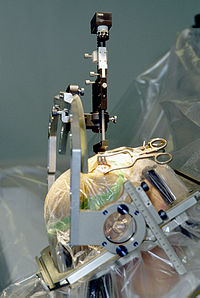
Photo from wikipedia
INTRODUCTION Intraoperative seizures (IOSs) during awake craniotomy (AC) are associated with significant morbidity. The reported incidence of IOS is between 3% and 30%. The aim of this study was to… Click to show full abstract
INTRODUCTION Intraoperative seizures (IOSs) during awake craniotomy (AC) are associated with significant morbidity. The reported incidence of IOS is between 3% and 30%. The aim of this study was to identify risk factors for IOS during AC for elective resection or biopsy of a space-occupying brain lesion. METHODS In this retrospective study, we reviewed the records of all awake craniotomies performed by a single neurosurgeon at a single university hospital between July 2006 and December 2018. IOS was defined as a clinically apparent seizure that occurred in the operating room and was documented in the medical records. Explanatory variables were chosen based on previously published literature on risk factors for IOS. RESULTS Five hundred and sixty-two patients had a total of 607 AC procedures during the study period; 581 cases with complete anesthesia records were included in analysis. Twenty-nine (5.0%) IOS events were reported during 29 (5%) awake craniotomies. Most seizures (27/29; 93%) were focal in nature and did not limit planned intraoperative stimulation mapping. Variables associated with IOS at a univariate P-value <0.1 (frontal location of tumor, preoperative radiotherapy, preoperative use of antiepileptic drugs, intraoperative use of dexmedetomidine, and intraoperative stimulation mapping) were included in a multivariable logistic regression. Frontal location of tumor (adjusted odds ratio: 5.68, 95% confidence interval: 2.11-15.30) and intraoperative dexmedetomidine use (adjusted odds ratio: 2.724, 95% confidence interval: 1.24-6.00) were independently associated with IOS in the multivariable analysis. CONCLUSIONS This study identified a low incidence (5%) of IOS during AC. The association between dexmedetomidine and IOS should be further studied in randomized trials as this is a modifiable risk factor.
Journal Title: Journal of neurosurgical anesthesiology
Year Published: 2021
Link to full text (if available)
Share on Social Media: Sign Up to like & get
recommendations!